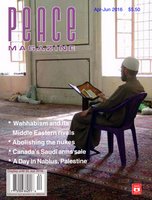
Peace Magazine Apr-Jun 2016, page 30. Some rights reserved.
Search for other articles by John Bacher here
War, Revolution, and the Making of the Cambodian Diaspora. By Khatharya Um. New York: New York University Press, 2015
American political scientist Khatharya Um is the first Cambodian-American woman to receive a doctoral degree. This unusual success in a traumatized community of exiles helped shape her perspective in the rare and poignant account of From the Land of Shadows.
From the Land of Shadows is a book that many should read. There is tragically little in popular films, books, or televised accounts describing what the author accurately calls “almost two million of the country’s estimated seven million people” who perished. In less than four years of brutal “Democratic Kampuchea” rule, they died “from hard labor, disease, starvation, executions, and disappearances.” In the wake of the country’s 1979 collapse, this resulted in a population composed mostly of women and children. In addition to the two million dead, some 600,000 Cambodians fled, of whom 100,000, including Um, settled in the United States.
Um eschews temptations to give ideologically simplistic accounts of Cambodia’s tragic self-genocide. She is careful to explain how important details are still kept in the shadows, quite unlike the meticulous record-keeping of Nazi Germany’s Holocaust. Her search for truth is vividly expressed by how she tells the story of the best-documented records of Camp S 21, also called Tuol Seng.
Although some of the archives of S21 have been culled, this death camp where 12,000 perished is the best preserved of the killing fields of Kampuchea.The reason for this is that the slaughter continued up until stopped by the arrival of Vietnamese troops, who subsequently turned the facility into a genocide museum. Those who perished here were from the Khmer Rouge elite that ruled the country from 1976 to 1979. They later got into trouble for attempting to moderate the regime’s brutality. In what have been called the “Tuol Seng confessions,” documents reveal that some who perished here were executed for such crimes as being concerned about mass starvation and opposing rapid collectivization and de-urbanization.
Um documents how S21-Tuol Seng is a relatively well-documented tip of the iceberg of genocide during Kampuchea’s existence. New death camps are still being discovered and 250 have been uncovered in the southwest part of Cambodia alone. In a revealing passage, Um explains that, “Many were hidden in vacated monasteries—traditional sanctuaries of nonviolence—and in innocuous-looking villages, often shrouded from external scrutiny by verdant banana groves.”
One of the cruel ironies that Um reveals is that the only person punished for the crime of Cambodia’s self-genocide is the former head of the Tuol Seng extermination center, Kaing Guek Eav, known by his alias, Dutch. The slow process that resulted in his conviction and sentence to 35 years in prison was only started in 2006, when the Extraordinary Chambers of the High Courts of Cambodia, (ECC) was created. The ECC is a hybrid court of international and Cambodian judges. The conviction came after Dutch attempted to blame the American government for the creation of the Khmer Rouge in a year-long trial. So far, the ECC’s expenses, which involve the ongoing trials of four other high officals, have come to $200 million.
Reviewed by John Bacher, a St Catharines-based activist and editor of Peace.

Peace Magazine Apr-Jun 2016, page 30. Some rights reserved.
Search for other articles by John Bacher here